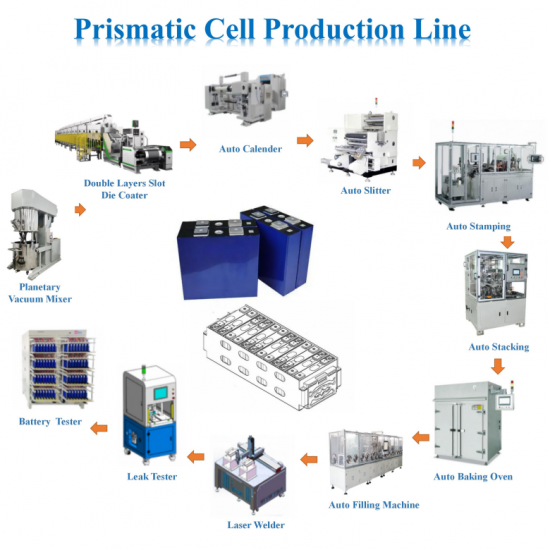Lith Corporation, founded in 1998 by a group of material science doctor from Tsinghua University, has now become the leading manufacturer of battery lab&production equipment. Lith Corporation have production factories in shenzhen and xiamen of China.This allows for the possibility of providing high quality and low-cost precision machines for lab&production equipment,including: roller press, film coater,mixer, high-temperature furnace, glove box,and complete set of equipment for research of rechargeable battery materials. Simple to operate, low cost and commitment to our customers is our priority.
What is an EV Car Battery Fabrication Plant?
An EV (Electric Vehicle) Car Battery Fabrication Plant is a largescale or midscale industrial facility dedicated to the design, development, and production of battery cells used in electric vehicles. Unlike battery pack assembly or module integration plants, a fabrication plant focuses on the core manufacturing of battery cells, including:
Electrode preparation (anode and cathode)
Cell assembly (pouch, cylindrical, or prismatic formats)
Electrolyte filling and sealing
Formation and aging processes
Quality control and testing
This type of plant serves as the foundation of the EV battery supply chain, enabling companies to produce highperformance, safe, and costeffective battery cells for integration into EVs, energy storage systems, or other applications.
Key Objectives of an EV Battery Fabrication Plant
1. Produce HighQuality Battery Cells at Scale
Ensure consistency, reliability, and performance across millions of cells
Meet automotivegrade standards for safety, durability, and efficiency
2. Support Multiple Battery Chemistries
Enable production of various chemistries such as:
NMC (Nickel Manganese Cobalt)
LFP (Lithium Iron Phosphate)
SolidState
SodiumIon
Silicon Anode
LithiumSulfur
3. Enable Flexible Manufacturing
Adapt to changing market demands and evolving battery technologies
Support multiple cell formats (pouch, cylindrical, prismatic)
4. Optimize Cost and Efficiency
Reduce manufacturing costs through automation and process innovation
Improve energy efficiency and reduce waste
5. Ensure Functional Safety and Compliance
Meet global standards such as:
UN38.3 (transport safety)
IEC 62660 (cell safety for EVs)
ISO 26262 (functional safety)
IATF 16949 (automotive quality management)
6. Promote Sustainable and Responsible Production
Use ecofriendly materials and processes
Support battery recycling and secondlife applications
Minimize carbon footprint and environmental impact
Core Stages in an EV Battery Fabrication Plant
A typical EV battery fabrication plant includes the following key production lines and support systems:
1. Slurry Mixing and Electrode Coating
This is where the active materials (cathode and anode) are mixed into a slurry and coated onto metal foils.
Key steps include:
Raw material handling: Cathode (e.g., NMC, LFP), anode (e.g., graphite, silicon), binders, solvents
Slurry preparation: Highshear mixing to ensure homogeneity
Coating: Slotdie coating, doctorblade, or spray coating on aluminum (cathode) or copper (anode) foils
Drying: Removing solvents in hightemperature ovens under controlled environments
Calendering: Compressing the electrode to achieve desired density and thickness
Slitting: Cutting the coated foils into precise widths for cell assembly
2. Electrode Processing and Stacking/Winding
After coating, the electrodes are further processed and assembled into a cell structure.
Steps include:
Tab welding: Attaching current collector tabs to the electrodes
Stacking or winding: For pouch or cylindrical cells respectively
Separator placement: Inserting porous separators between anode and cathode
Jelly roll formation: In cylindrical cells, the electrode stack is wound into a compact roll
Insertion into can or pouch: Electrode stack is placed into a metal can or aluminum pouch casing
3. Cell Assembly and Encapsulation
This stage involves sealing the cell and preparing it for electrolyte filling.
Activities include:
Case welding: Sealing the top of the cell can or pouch
Laser welding: Ensuring airtight and leakproof enclosures
Venting and safety valve installation: For cylindrical and prismatic cells
Electrolyte filling: Under ultradry conditions (<1% RH) in a dry room
Sealing: Final closure of the cell to prevent moisture ingress
4. Formation and Aging
Once the cell is sealed, it undergoes its first charge/discharge cycle, known as formation, by a resting period called aging.
This stage includes:
Initial charging: Activates the cell and forms the SEI (solid electrolyte interphase) layer
Discharge and recharge: Verifies initial capacity and performance
Aging: Allows the cell to stabilize and any internal gases to settle
Sorting: Based on voltage, internal resistance, and capacity matching
5. Final Testing and Quality Control
Each cell is rigorously tested before being approved for integration into modules and packs.
Testing includes:
Electrical testing: Voltage, capacity, internal resistance
Cycle testing: Simulates longterm use and degradation
Safety testing: Overcharge, short circuit, thermal runaway
Mechanical testing: Vibration, shock, compression
Environmental testing: Temperature extremes, humidity
Dimensional inspection: Ensures cell meets design specifications
6. Packaging and Logistics
Once tested and approved, cells are packaged and prepared for shipment.
This includes:
Cell grading and sorting: Based on performance metrics
Packaging: Antistatic containers, humidity control
Labeling and traceability: Barcodes or QR codes for tracking
Shipping preparation: Compliance with UN38.3 and IATA regulations
Prismatic Cell Manufacturing Line
Supporting Infrastructure in a Battery Fabrication Plant
To ensure smooth and safe operations, the following systems are essential:
1. Clean Room and Dry Room Systems
Ultralow humidity zones (<1% RH) for electrolyte filling and electrode handling
HEPA filtration to remove particulates
Climatecontrolled storage for raw materials and finished cells
2. Fire Safety and Explosion Protection
Gas detection systems for solvent vapors and electrolyte leaks
Inert gas blanketing in solvent mixing and drying zones
Fire suppression systems using clean agents or water mist
Explosionproof enclosures for flammable processes
3. Waste Management and Sustainability
Solvent recovery systems – Reuse of NMP (NMethyl2pyrrolidone)
Battery recycling integration – Closedloop material recovery
Energyefficient HVAC and lighting
Water treatment systems – For cleaning and process water
4. Digital Manufacturing and Process Control
MES (Manufacturing Execution System) – Realtime data tracking
IoT sensors and PLCs – Monitor pressure, temperature, humidity
AIbased vision systems – Detect defects in electrodes and cells
Traceability systems – Track every cell from raw materials to shipment
5. Automation and Robotics
Automated conveyor systems – Move materials and components
Robotic arms – Handle electrodes, stack components, and load/unload machines
Laser welding and cutting – Highprecision joining and trimming
Smart testing systems – Autosort cells based on test results
Types of EV Battery Fabrication Plants
Depending on ownership, scale, and technology focus, these plants can be categorized as:
1. Gigafactories
Largescale production (10–100 GWh/year)
Owned by major OEMs or battery suppliers
Example: Tesla Gigafactory Nevada, CATL, LG Energy Solution
2. National Battery Hubs
Governmentsupported initiatives to build domestic battery capability
Aim to attract investment and create jobs
Example: India’s ACC PLI scheme, EU Battery Innovation Hub
3. OEMOwned Battery Plants
Operated by automotive companies to control battery supply
Example: BMW Group’s battery cell plant in Germany, Toyota’s plant in Japan
4. Battery Startup Fabrication Plants
Focused on niche technologies like solidstate or sodiumion
Example: QuantumScape, Factorial, Blue Solutions
5. Joint Ventures and Consortium Plants
Shared ownership between OEMs and suppliers
Example: Ford + SK On, Stellantis + Samsung SDI, VW + Umicore
Key Considerations When Building an EV Battery Fabrication Plant
When planning your battery fabrication plant, consider the following factors:
| Area | Consideration |
|||
| Location | Proximity to raw materials, logistics, and skilled workforce |
| Battery Chemistry | NMC, LFP, solidstate, etc. |
| Cell Format | Pouch, cylindrical, or prismatic |
| Annual Capacity | Target output (e.g., 1–10 GWh/year) |
| Automation Level | Manual, semiauto, or fully automated |
| Factory Layout | Workflow, clean room placement, scalability |
| Environmental Compliance | Fire safety, emissions, waste treatment |
| Workforce Development | Training engineers, technicians, and operators |
| Partnerships | Suppliers, OEMs, research institutions |
Benefits of an EV Battery Fabrication Plant
Reduces dependency on external battery suppliers
Improves control over quality, cost, and innovation
Enables customization for specific vehicle platforms
Strengthens local or national battery supply chains
Supports job creation and economic development
Accelerates the transition to electric mobility
Encourages sustainable and circular battery ecosystems
Leading Companies and Institutions Involved in EV Battery Fabrication Plant Development
Here are some of the key players involved in designing and operating EV battery fabrication plants globally:
Battery Manufacturers:
CATL (China) – World’s largest battery producer
LG Energy Solution (South Korea) – EV battery gigafactories
Samsung SDI (South Korea) – Highenergydensity cells
BYD (China) – LFP and blade battery technology
Panasonic (Japan) – Partner of Tesla, cylindrical cell specialist
Automotive OEMs:
Tesla (USA) – Gigafactories for NMC and LFP cells
Volkswagen Group (Germany) – Cellforce Group for solidstate batteries
Ford Motor Company (USA) – Joint venture with SK On
BMW Group (Germany) – Strategic battery partnerships and internal R&D
Toyota (Japan) – Solidstate battery development and plant construction
Equipment and Automation Providers:
KUKA (Germany) – Robotics and automation
Siemens (Germany) – MES and digital twin platforms
Trumpf, Coherent, IPG Photonics – Laser welding and cutting
Hanson Robotics, Gree EnergyTech – Integrated battery line solutions
B&R Automation (ABB subsidiary) – Smart manufacturing systems
Engineering and EPC Firms:
Bechtel, Hatch, Black & Veatch – Turnkey plant construction
Wood, Jacobs, GHD – Engineering and sustainability consulting
Need Help Designing or Optimizing Your EV Battery Fabrication Plant?
If you're looking to build, expand, or optimize your EV battery fabrication plant, I can help you with:
Master planning – Site selection, process flow, zoning
Process engineering – Battery chemistry, format, and production stages
Factory layout design – Clean/dry room integration, workflow
Equipment sourcing – Bestinclass machinery and automation
Sustainability strategy – Green energy, recyclability, circular economy
Cost estimation and ROI analysis – CapEx, OpEx, breakeven modeling
Compliance and safety systems – Fire protection, permits, worker safety
All you need to do is provide the following information:
Battery chemistry and cell format (e.g., NMC, LFP, solidstate, pouch)
Target annual production capacity (e.g., 1–10 GWh/year)
Plant location and available infrastructure
Level of automation and digitalization desired
Current team expertise and strategic goals




 Online service
Online service
